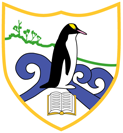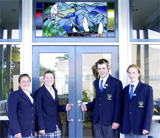Students at The Catlins Area School are working towards exciting new career opportunities in the aviation industry. A shortage of young people entering the aviation industry was identified by Service IQ, and the school welcomed the opportunity to respond.
The school's strategic development plan had already identified tourism and related themes as key areas for development. A community consultation had seen the need to develop engineering related opportunities for students, so aviation training fitted nicely into this larger picture.
In developing this project, The Catlins Area School used a broad definition of ‘community’ to include all project stake-holders, from the national aviation business and work community, through to the eLearning community, learners, and their whānau.
Community engagement principle
The Catlins Area School brings the community engagement principle to life by considering ways to connect learning with their students’ wider lives. They have used a local, meaningful context for learning which has enabled the school to grow educationally powerful relationships with local businesses and whānau. The decision to incorporate aviation studies into their local curriculum was made in direct response to community need.
Giving our students real life experiences
The programme has a high level of engagement with the aviation community which provides real-world relevance for students.
A range of ICT tools have been developed to implement the programme and to support the ongoing process of consultation and collaboration between the parties involved. An eLearning course was developed, and offered through OtagoNET.
Following consultation with Aviation industry representatives, students from outside the OtagoNET cluster were invited to enrol as fee paying STAR students.
Through Nextspace’s involvement, the programme began using 3D visualisation tools, enabling students to see and manipulate parts of aircraft as an aspect of the learning process.
Additional teaching resources, including video footage of people doing real jobs on real aircraft in a workplace situation have resulted from a partnership with the regional airline, Air Fiordland. In addition, the school consulted with officers from the RNZAF about the development of some aspects of the project. Recently, the Christchurch Engine Centre donated a retired Pratt & Whitney JT8D jet engine as a teaching aid.
Aviation studies and the New Zealand Curriculum
The programme relates to the effective pedagogy section of the new curriculum in a number of ways. ICT tools, used not only for the delivery of the course, but also for the development of peer interactions as a class, help students take steps towards becoming more deeply connected with their world. Students improve as users of communications tools and take steps towards becoming members of a national learning community.
As the programme continues to attract international eLearning students, these connections will help the New Zealand based learners become international citizens with a greater understanding of their place within the world.
Aviation has a particular focus on the key competency 'using language, symbols and texts', as aviation has a culture and language of its own.
It provides an integrated learning experience with both ‘teacher’ and industry stressing the same message to learners, that:
- learning is not separate from life
- learning is not restricted to institutions
- learning is conscious and continuous.
This was an ideal way to combine the curriculum and the Secondary Futures Project. The school incorporated other key ideals from the Secondary Futures Project into the development of the programme, such as highlighting to students that their learning is recognised as crucial to success not only by the school but also by the community.
This approach to aviation teaching and learning has been coupled with a broader move to implement inquiry learning throughout the school. Within this framework, planning is based on generative questions whilst drawing on the availability of experts and community involvement. Students are involved in planning and developing the topics, which gives them a stronger voice in their learning. Teachers are using a manageable framework for explicit teaching of thinking skills, tools, language and strategies at different year levels
Effective pedagogy
Teachers at Catlins Area School have considered their use of effective pedagogy to support aviation studies. Their use of ICT has:
- facilitated shared learning
- offered students virtual learning experiences
- presented new learning in multiple ways
- allowed students to connect with international students and experts in the wider community.
You might like ...
Learning locally – Connecting kids to their community
Are you looking for ways to explore and develop your local curriculum? One way to get started is to identify the rich learning opportunities that exist in your own community. This blog offers some ideas, stories, and questions to help your students “learn locally”.
- Tags:
- community engagement
- effective pedagogy
- secondary
Return to top


